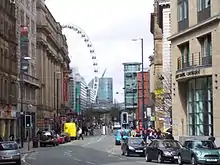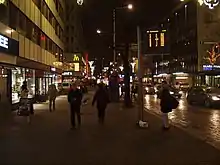Inner city
The term inner city has been used, especially in the United States, as a euphemism for lower-income residential districts, sometimes but not exclusively referring to African-American neighborhoods, in a downtown or city centre area.[1] Sociologists sometimes turn this euphemism into a formal designation, applying the term "inner city" to such residential areas, rather than to geographically more central commercial districts.


The word "downtown" is also used to describe the inner city or city centre – primarily in North America – by English-speakers to refer to a city's commercial, cultural and often the historical, political and geographic heart, and is often contiguous with its central business district. In British English, the term "city centre" is most often used, "centre-ville" in French, Stadtzentrum in German, or shìzhōngxīn (市中心) in Chinese). The two terms are used interchangeably in Canada. A few US cities, such as Philadelphia, use the term "Center City".
Etymology
The term "inner city" first achieved consistent usage through the writings of white liberal Protestants in the US after World War II, contrasting with the growing affluent suburbs. According to urban historian Bench Ansfield, the term signified both a bounded geographic construct and a set of cultural pathologies inscribed onto urban black communities. Inner city thus originated as a term of containment. Its genesis was the product of an era when a largely suburban mainline Protestantism was negotiating its relationship to American cities. Liberal Protestants’ missionary brand of urban renewal refocused attention away from the blight and structural obsolescence thought to be responsible for urban decay, and instead brought into focus the cultural pathologies they mapped onto black neighborhoods. The term inner city arose in this racial liberal context, providing a rhetorical and ideological tool for articulating the role of the church in the nationwide project of urban renewal. Thus, even as it arose in contexts aiming to entice mainline Protestantism back into the cities it had fled, the term accrued its meaning by generating symbolic and geographic distance between white liberal churches and the black communities they sought to help.[2]
Urban renewal
Urban renewal (also called urban regeneration in the United Kingdom and urban redevelopment in the United States[3]) is a program of land redevelopment often used to address urban decay in cities. Urban renewal is the clearing out of blighted areas in inner cities to clear out slums and create opportunities for higher class housing, businesses, and more.
In Canada, in the 1970s, the government introduced Neighbourhood Improvement Programs to deal with urban decay, especially in inner cities.[4] Also, some inner-city areas in various places have undergone the socioeconomic process of gentrification, especially since the 1990s.[5]
See also
References
- "BBC - Higher Bitesize Geography - Urban : Revision, Page4". bbc.co.uk. Retrieved 7 April 2018.
- Bench Ansfield, "Unsettling 'Inner City': Liberal Protestantism and the Postwar Origins of a Keyword in Urban Studies" Antipode (2018)
- "HUD Revitalization Areas". Archived from the original on 15 October 2016. Retrieved 2 October 2016.
- https://core.ac.uk/download/pdf/144470328.pdf
- "State of Metropolitan America, Part II, "Race and Ethnicity"" (PDF). brookings.edu. p. 62. Archived from the original (PDF) on 30 May 2010. Retrieved 7 April 2018. (Brookings Institution) and its analysis in Gurwitt, Rob (July 2008). "Atlanta and the Urban Future". Governing. Retrieved April 5, 2010. — see example in Demographics of Atlanta: Race and ethnicity
Further reading
- Ansfield, B. (2018) "Unsettling 'Inner City': Liberal Protestantism and the Postwar Origins of a Keyword in Urban Studies" Antipode 50, no. 5.
